Standing in the lift line at 7:15 a.m. at the Saas-Fee Valley Station with about every national alpine team in the world and just about one cup of coffee in my system wasn’t that bad after all. I just arrived the day before from Washington, DC and took the Swiss rail train to Visp. From Visp I had to travel for another hour on the bus up to the resort Saas-Fee. The night before the summer ski area had received some snow on top of the glacier, which was a very good indication that the next day would be a good day for training until 1:30 p.m. Since I have skied most of my life in Switzerland I assured myself I would have some time on top of the mountain at the home of the world’s highest rotary restaurant, Allalin, to get a perfect brewed espresso with my English and Irish friends. My assignment for the week was to provide excessive skiing performance training.
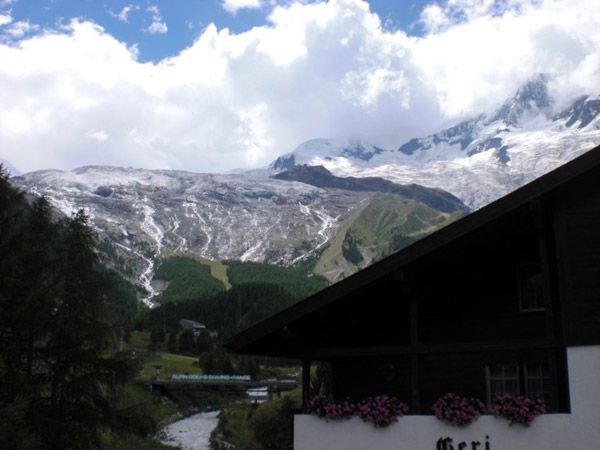
|
|
Saas-Fee, Switzerland, in late July, 2008.
|
Well, regarding the espresso I did get my cup and was more than ready after about one hour up the mountain. The sky was covered in a deep blue and the air was crystal clear. The snow was pure crisp with a shimmer of fresh snow. The panorama was breathtaking and, let me tell you, it literally will take your breath away at 10,000 ft.
The agenda for our first day on skis was to get our ski legs back and to discover the ski area. The summer ski area has three T-bars, six wide slopes, and a terrain park. After three hours on skis I felt a little dehydrated. We rested at the bottom of the first t-bar where it looked like a camp, pack backs and material everywhere. Drinking water at such high altitude is very important, especially when you’ve been running gates for the past three hours. My friends learned very soon, after my first evaluation on snow, when I said we will work on specific skills that in my vision, we will do drills over and over again. Fine tuning is the key in such a high level of professionalism.
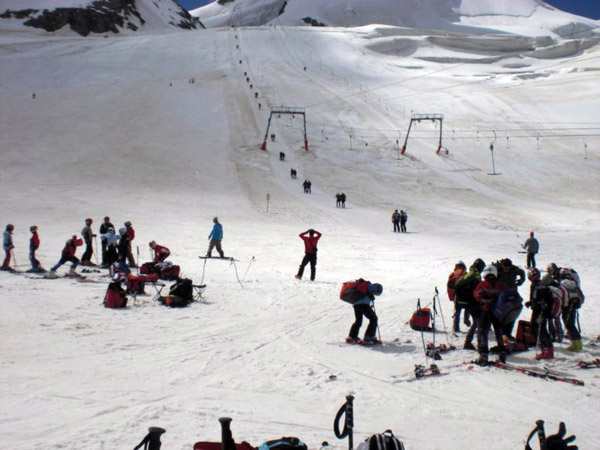
|
|
|
At around 11 a.m. the condition became spring-like: heavy and wet. We started to go back at around 1 p.m. that day to the station where we had to take the train to the first cable car. The summer ski area is in a bowl covered by high peaks. To get to the ski area you had to ski on carved-in trails for about 500 meters. In the morning this set up wasn’t so hard because you can take a step drop to the first t-bar. The way back wasn’t that easy because you had to skate the last 200 meters to the station.
Being in the cable car at this moment in time was the perfect moment for me to enjoy the panorama. It is tough to describe the beauty you can see, as well as, history in the making in one instant. We saw small ice blocks falling from the tong of the glacier into small valleys. The sound of crevasses opening was incredible since the echo traveled through the bowl. At this time I was reminded again why most of us choose this sport. For me it’s Mother Nature with all its attractiveness you can see near and far. It also recaps the challenges and consequences our sport can bring with it. Those feelings are met with reality when you see the many decorated crosses, little chapels, and churches in town and around the mountain area.
All mountaineering guide teams had a tradition in the early morning hours - going to church. Switzerland’s mountain areas are mostly Catholic regions and since the early start of mountain guiding in the 18th century the guides went to their Saints. It’s much embedded in the Swiss culture, as well as in all alpine nations around Switzerland. Still today many guides still go to church before taking off. Many villages have memorials for those lost in the deep mountain areas. It puts everything in perspective for anyone how dangerous it still is even with all the modern equipment.
Back to the Valley Station, we had to walk a short walk to the hotel over a valley bridge. Most days I was so tired I slept about two to three hours in the afternoon. Every day we had video analysis and feedback for our athletes after a great traditional Swiss dinner. Many of our athletes had to get used to the meals, which in many cases, are a balance of heavy Germanic and some light foods. Many athletes had to get used to the Swiss drink, Rivella, a carbonated drink with milk cerium, which is a national drink and a main sponsor of the national Swiss alpine team. It’s a great drink, especially in such altitude, but again some people are not used to its ingredients. It also comes in a green tea version.
The entire village was as busy as most East resorts in the winter. If you have ever watched the FIS World Cup or the winter Olympics you would recognize many skiers at the resort. At the resort base many languages were spoken and still everyone understood each other or at least we pretended. My coaching was held most of the time in English and sometime in German and … yes, sometimes I gave feedback to an English speaking athlete in German … well, anyway I survived.
Night life was plentiful but in many cases racers went to bed around 9 p.m. Well, I guess much later would be almost impossible after a combination of great winter and spring skiing at the same time for 6 hours a day.
Anyway, I still made it twice past 9 p.m. Many racers and coaches went to the “Why Not Bar” in town -; a traditional mix of Irish/English and Swiss Bar. Even though there are plenty of bars at the resort, in the summer time, especially since most visitors are pro skiers and coaches, the night life concentrates itself to a few bars. On the other hand the grocery stores are in high demand every day after 2 p.m. Everyone gets their food and drinks for the day since Switzerland is one of the most expensive countries in the world. It’s the cheapest way for most of us to survive. Our crew went to the local Coop or Migros to get our stuff so we could go back to our hotel to play a card game or talk about the differences in teaching and coaching.
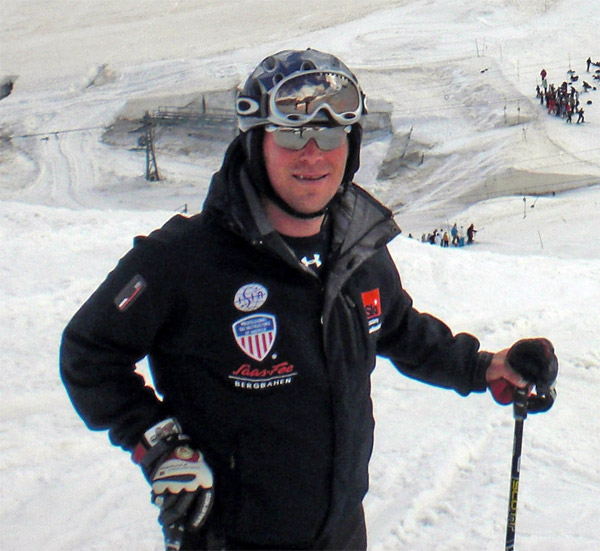
|
|
Iwan Fuchs, Ski Academy Switzerland Coach. Photo provided by Mark Farmer.
|
One of the other coaches was Bill Beerman from Stratton, Vermont, a PSIA national board member and a PSIA-E examiner. We not only skied together, but talked about the differences I faced after my first year as the Seven Springs Snowsports School Director in Pennsylvania. When we went up the mountain I could tell that he wasn’t used to carrying all his equipment with him… one of many differences we all face.
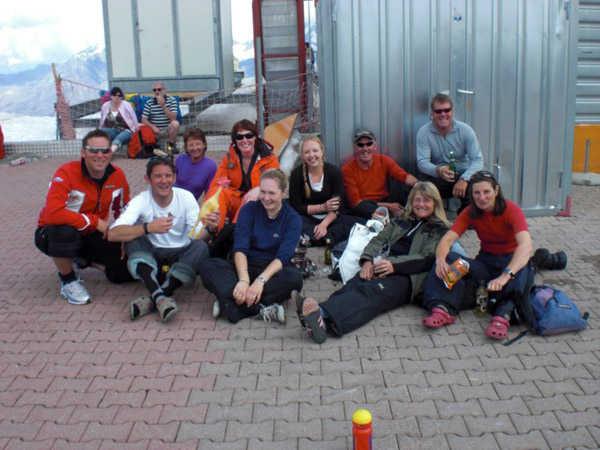
|
|
|
Saas-Fee always had great weather for us during the Ski Academy Switzerland week. We had one day with a lot of clouds, fog and rain/snow. A typical ski day in the summer in Saas-fee starts at 7 a.m. at the Valley Station, ready to get up to the summer ski area. It takes about one hour for the way up. You can ski until around 1 p.m. or sometimes until 1:30 p.m. The snow in the morning is icy and well groomed until about 11 a.m. After 11:00 you will ski in spring conditions. You also will see more splits in the slopes. You know at this time that the glacier is alive and not sleeping.
Photos provided by Iwan Fuchs, Mark Farmer, and James Wilkinson.
Iwan Fuchs currently serves as the Snowsports School Director at Seven Springs Resort. He has over 18 years of experience teaching, and has served as a certified Swiss ski instructor in his native Switzerland. He has also been a USSA racing coach.
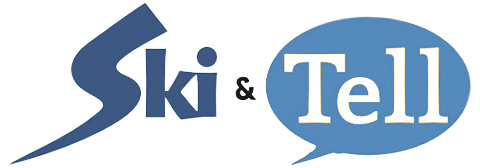
Join the conversation by logging in.
Don't have an account? Create one here.